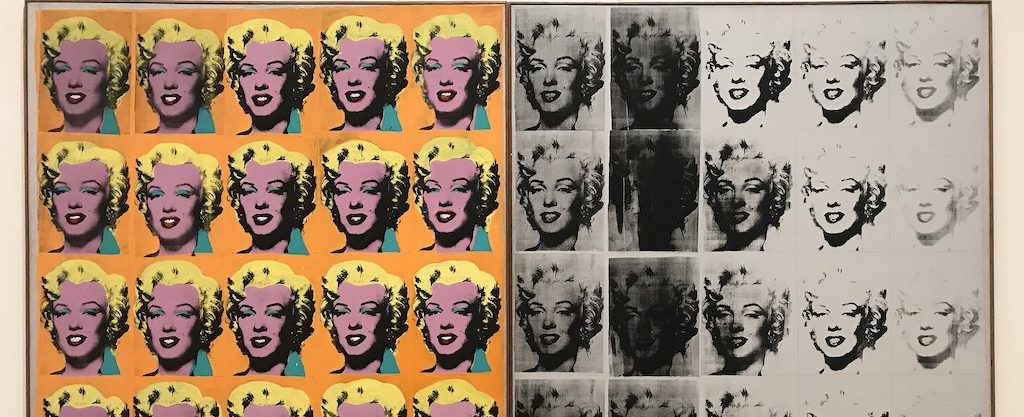The Art in the 1970s: a critical period
The 1970s were a pivotal decade in artistic history, witnessing the emergence of postmodernism and pop art, as well as a new aesthetic that blended high and low culture. Postmodernism was a reaction against modernism, a movement that dominated the art scene from the 1860s to the 1970s and was founded on the principles of reason, clarity, and idealism. The arrival of postmodernism in the 1970s transformed art on a global scale, embracing a new sense of freedom that championed authority and advocated suspicion of reason. It also introduced the idea that there isn’t one single definition of what art should be, but that it consists of multiple layers of meaning to be unpacked, and drawing from different artistic styles is a crucial method in doing so.
The Marilyn Diptych explores the impact of celebrity culture
Pop art was a distinctive postmodern art movement that was born in the ‘50s and popularised in the ‘60s and ‘70s, at a time when hippie, psychedelic art, and fashion were beginning to emerge. This artistic and cultural shift was accelerated through the rise of glam rock stars such as David Bowie, who experimented with bold, androgynous looks. There is no doubt that pop art was revolutionary, often tying in elements of comic books, mass consumerism. and commercial culture, while simultaneously acting as a social commentary on topics such as celebrity culture and war.
Andy Warhol’s ‘Marilyn Diptych’ explores the impact of celebrity culture, created just months after Marilyn Monroe died in 1962. Warhol repeats Marilyn’s face 50 times across the two panels that make up the diptych. Half are made up of bright hues—vivid pinks, blues, and yellows—which mirror the opulence and glamour of celebrities. The other half is made up of a silver underpaint and black overlay. In this panel, the black ink distorts Marilyn’s face and fades near the final column. This gives the piece an eerie feel, symbolising the destructive effect of the tabloid papers, which both tortured the actress in life and glamorised her death.
This artistic style undeniably gave Warhol the freedom to experiment with the relationship between life and death, as well as to comment on how the idolisation and promotion of the cult of celebrity life can induce great despair and tragedy in their lives. This is perhaps even more relevant today, with social media largely contributing to the distorted image of celebrity and the fleeting and futile nature of fame. Warhol himself predicted celebrity culture in the modern world, stating that “in the future, everyone will be world-famous for 15 minutes”.
The comic book style reinforces that art itself is a commodifiable product
Roy Lichtenstein has also greatly influenced the Pop Art movement, and is most notably known for his 1963 painting, ‘Whaam!’, in which he critiques a post-war commodity-driven world. In the image, an American fighter plane shoots a missile at an enemy, accompanied by the text, “I pressed the fire control. Ahead of me, rockets blazed through the sky.” Our eyes are subsequently drawn to a consequential explosion: streaks of red, white, and yellow with the word “Whaam!” spilling out in bold, yellow lettering. This violent subject matter is contrasted with its presentation as a fictional comic strip, which features bright and clean lines. This desensitised and almost frivolous depiction of war represents widespread emotional detachment from violence, alluding to its prevalence in the news and media. It must be noted that ‘Whaam!’ was created in the context of the Vietnam War, when anti-war sentiment was high. Perhaps this explains the comic-book appropriation, which parodies American propaganda and illuminates the absurdity of the juvenile obsession with conflict. The use of the comic-book style also reinforces the notion that art itself is a commodifiable product, uniting high art with the commercial.
Similarly, art as an anti-war response has been further explored through video and performance art, which emerged in the ‘70s. In 1971, Chris Burden, one of the most influential performance artists, asked his friend to shoot him with a .22 calibre rifle to protest against the Vietnam War. In ‘Doomed’ (1975), Burden laid under a large sheet of glass for 45 hours and 10 minutes. This symbolised his potential death and al- ludes to the inevitable passing of time, while simultaneously blurring the line between body and canvas.
While the art scene is still rapidly evolving, with continual access to new mediums and methods of using them, I believe the 1970s art industry has, and will continue to have, a profound influence on the art world and popular culture. The impact of pop art on visual culture alone can be seen through the minimalism of Apple’s logo and the multi-colored typography of Google design, among others. However, the industry ultimately instigated a new era of unrestrained freedom of expression, laying the groundwork for the exploration of new subject matter and social critique.

Comments